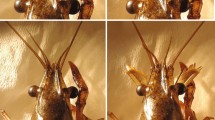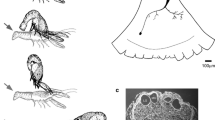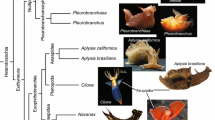Summary
-
1.
Electromyograms (EMGs) from phasic abdominal muscles of unrestrained and variously restrained crayfish were used to study the involvement of sensory information in phasic abdominal extension during escape behavior.
-
2.
Lateral giant neuron impulses (escape commands), elicited either with natural stimuli or via direct shocks, caused a flexion which was followed at short and near-constant latency by extension (Figs. 1 and 2).
-
3.
Extension produced as above was termed ‘postgiant’ extension and had the following properties: it was labile (Figs. 3 and 4), it was eliminated when flexion was prevented, and it was reduced or eliminated if flexion was hampered (Fig. 5 and Table 1).
-
4.
The above observations, which suggest sensory involvement in post-giant extension, are complemented by the observation that phasic extensor activity could be evoked without prior flexion by rapid water displacements over the abdomen or by taps to the abdomen (Fig. 7).
-
5.
In addition to post-giant extension the extensors were active during many kinds of non-giant tailflips. During swimming, non-giant extensionpreceded flexion at short and constant latency (Fig. 9) and persisted after flexor root section (Fig. 10) or during restraint. Non-giant extension was not labile (Fig. 11), and it depended on the integrity of the rostral nervous system.
-
6.
Animals frequently initiate escape with a giantmediated tailflip followed by non-giant swimming. When this occurred our most common observation was consistent with the interpretation that both postgiant and non-giant extension occurred between the first two flexions (Figs. 13 and 14).
-
7.
We interpret our results to mean that extension occurs as a chained reflex following giant-mediated flexion, with subsequent control of the extensors passing to a central pattern generator.
Similar content being viewed by others
References
Alexandrowicz JS (1951) Muscle receptor organs in the abdomen ofHomarus vulgaris andPalinurus vulgaris. Q J Microsc Sci 92:163–199
Bethe A (1897) Das Centralnervensystem vonCarcinus maenas. Ein anatomisch-physiologischer Versuch. I. Theil, II. Mittheil Arch Mikrosk Anat Entwicklungsmech 50:589–639
Brown TG (1914) On the nature of the fundamental activity of nervous centres; together with an analysis of the conditioning of rhythmic activity in progression, and a theory of the evolution of function in the nervous system. J Physiol 48:18–46
Bryan JS, Krasne FB (1977) Presynaptic inhibition: the mechanism of protection from habituation of the crayfish lateral giant escape response. J Physiol 271:369–390
Grillner S (1975) Locomotion in vertebrates: central mechanisms and reflex interaction. Physiol Rev 55:247–304
Kandel ER (1976) The cellular basis of behavior. Freeman Press, San Francisco
Kennedy D, Calabrese RL, Wine JJ (1974) Presynaptic inhibition: primary afferent depolarization in crayfish neurons. Science 186:451–454
Krasne FB, Bryan JS (1973) Habituation: regulation through presynaptic inhibition. Science 182:590–592
Krasne FB, Wine JJ (1975) Extrinsic modulation of crayfish escape behaviour. J Exp Biol 63:433–450
Kuwada JY, Wine JJ (1979) Crayfish escape behaviour: commands for fast movement inhibit postural tone and reflexes, and prevent habituation of slow reflexes. J Exp Biol 79:205–224
Kuwada JY, Hagiwara G, Wine JJ (1980) Postsynaptic inhibition of crayfish tonic flexor motor neurones by escape commands. J Exp Biol 85:343–347
Parnas I, Atwood HL (1966) Phasic and tonic neuromuscular systems in the abdominal extensor muscles of the crayfish and rock lobster. Comp Biochem Physiol 18:701–723
Pearson KG, Fourtner CR, Wong RK (1973) Nervous control of walking in the cockroach. In: Stein RB, Pearson KG, Smith RS, Redford JB (eds) Control of posture and locomotion. Plenum Press, New York, pp 495–514
Roberts A (1968) Recurrent inhibition in the giant-fibre system of the crayfish and its effect on the excitability of the escape response. J Exp Biol 48:545–567
Schrameck JE (1970) Crayfish swimming: alternating motor output and giant fiber activity. Science 169:698–700
Schrameck JE (1971) Neural coordination of alternating motor output in crayfish swimming. Ph D dissertation, Stanford University
Sherrington CS (1906) The integrative action of the nervous system. Yale University Press, New Haven, CT
Treistman SN, Remler MP (1975) Extensor motor neurons of the crayfish abdomen. J Comp Physiol 100:85–100
Wiersma CAG (1947) Giant nerve fiber system of the crayfish. A contribution to comparative physiology of synapse. J Neurophysiol 10:23–38
Wiersma CAG, Hughes GM (1961) On the functional anatomy of neuronal units in the abdominal cord of the crayfish,Procambarus clarkii (Girard). J Comp Neurol 116:209–228
Wiersma CAG, Furshpan E, Florey E (1953) Physiological and pharmacological observations on muscle receptor organs of the crayfishCambarus clarkii Girard. J Exp Biol 30:136–150
Wiese K (1976) Mechanoreceptors for near-field water displacements in crayfish. J Neurophysiol 39:816–833
Wine JJ (1971) Hyperreflexia in the crayfish abdomen and following denervation: evidence for supersensitivity in an invertebrate central nervous system. Ph D dissertation, University of California, Los Angeles, CA
Wine JJ (1977a) Neuronal organization of crayfish escape behavior: inhibition of the giant motoneuron via a disynaptic pathway from other motoneurons. J Neurophysiol 40:1078–1097
Wine JJ (1977b) Crayfish escape behavior. II. Command-derived inhibition of abdominal extension. J Comp Physiol 121:173–186
Wine JJ (1977c) Crayfish escape behavior. III. Monosynaptic and polysynaptic sensory pathways involved in phasic extension. J Comp Physiol 121:187–203
Wine JJ, Hagiwara G (1977) Crayfish escape behavior. I. The structure of efferent and afferent neurons involved in abdominal extension. J Comp Physiol 121:145–172
Wine JJ, Hagiwara G (1978) Durations of unitary synaptic potentials help time a behavioral sequence. Science 199:557–559
Wine JJ, Krasne FB (1972) The organization of escape behaviour in the crayfish. J Exp Biol 56:1–18
Wine JJ, Krasne FB (1981) The cellular organization of crayfish escape behavior. In: Bliss DE (ed) The biology of crustacea, vol 3. Academic Press, New York (in press)
Wine JJ, Mistick DC (1977) Temporal organization of crayfish escape behavior: delayed recruitment of peripheral inhibition. J Neurophysiol 40:904–925
Author information
Authors and Affiliations
Additional information
We thank Jan Ruby for preparation of the manuscript and L.A. Miller, J.Y. Kuwada, M.R. Plummer, and K.A. Sigvardt for assistance and discussions. This research was supported by National Science Foundation Grant BNS 78-14179 and by a postdoctoral fellowship of the Deutsche Forschungsgemeinschaft to H. Reichert; J.J. Wine is an Alfred P. Sloan Research Fellow.
Rights and permissions
About this article
Cite this article
Reichert, H., Wine, J.J. & Hagiwara, G. Crayfish escape behavior: Neurobehavioral analysis of phasic extension reveals dual systems for motor control. J. Comp. Physiol. 142, 281–294 (1981). https://doi.org/10.1007/BF00605442
Accepted:
Issue Date:
DOI: https://doi.org/10.1007/BF00605442




